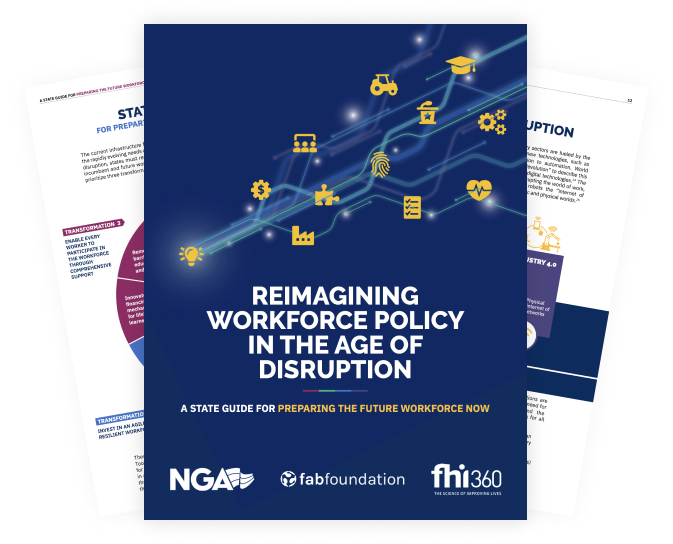Promote skills-based teaching and learning models that deliver and measure uniquely human skill development. The need for increasingly higher-skilled employees in the workplace demands innovations to the delivery of K-12 and postsecondary education, including learning assessments, online learning and competency-based education. Competency-based education offers a flexible way for students to earn credit based on demonstration of subject-matter knowledge learned either through personalized guided instruction or examinations based on mastery of competencies. Traditionally, this education model awards adult learners with competencies determined by industry leaders and local workforce representatives. Disruptive innovation in teaching and learning has the potential to serve as a game changer in the affordability and delivery of secondary and post-secondary education.
State Program Examples
-

Vermont
Flexible Pathways Initiative
Vermont enacted the Flexible Pathways Initiative, created by Act 77 of 2013 and found in statute under 16 V.S.A. § 941, to encourage and support the creativity of school districts as they develop and expand high-quality educational experiences that are an integral part of secondary education in the evolving 21st-century classroom. Flexible pathways promote opportunities for students to achieve postsecondary readiness through high-quality educational experiences that acknowledge individual goals, learning styles, and abilities. Flexible pathways also increase the rates of secondary school completion and postsecondary continuation in Vermont. The Flexible Pathways Initiative provides for expansion of the existing statewide Dual Enrollment Program and Early College Program; increases access to work-based learning, virtual/blended learning opportunities and Career and Technical Education; and requires that students in grades 7-12 complete personalized learning plans (PLPs).
-

Oregon
State Higher Education Commission Scales Competency-Based Learning
Passed in 2017, House Bill 3289 requires the Oregon Higher Education Coordinating Commission to submit annually a report to the legislature on progress made in providing competency-based education at public postsecondary institutions. The report must identify issues and barriers of expanding competency-based education, evaluate competency-based models to determine best practices and recommend specific policy actions institutions can implement to expand competency-based education.
-

Kansas
Community College Degree Qualifications Profile
Kansas City Kansas Community College (KSKCC) created an alternative system for documenting student achievement of Degree Qualifications Profile (DQP) proficiencies. KCSCC now requires that every course develop a Degree Profile Index (DPI) specifying which of the 21st Century Outcomes the course will assess. This enables educators to put 21st century skills, including proficiency of technology and digital tools, problem-solving skills, creativity, and socio-emotional awareness, at the center of curriculum development.
-

Oklahoma
Allows Competency Based Learning to Qualify for Financial Assistance
In 2015, Oklahoma introduced Senate Bill 504 to add institutions which offer online, competency-based degree programs to the list of eligible institutions which students participating in Oklahoma Promise (formerly Oklahoma Higher Learning Access Program) may attend. Like similar last-dollar scholarship programs, Oklahoma’s assistance program allows students whose families earn $50,000 or less to earn a college tuition scholarship to public institutions.
-

Multi-State
Western Governors University (WGU)
Western Governors University (WGU) is a competency-based, online university catering specifically to the adult student population looking to earn a bachelor’s or master’s degree. The university was created in 1995 by 19 U.S. governors wanting to break the mold of traditional higher education and is accredited by the Northwest Commission on Colleges and Universities (NWCCU). There are six state-affiliated universities including Indiana, Missouri, Nevada, Tennessee, Texas and Washington, though which WGU enrolls students from all 50 states. WGU’s unique curriculum offers students the opportunity to earn degrees through demonstration of competencies, and at a personalized learning pace, and to receive credit for prior learning.
-

West Virginia
Simulated Workplace
The West Virginia Department of Education has worked with committee experts from numerous businesses and industries throughout West Virginia to design the Simulated Workplace. This new educational initiative has been created to assist schools in implementing workplace environmental protocols that align with West Virginia workforce requirements, including professionalism, attendance and safety. Simulated Workplace has not only enhanced instructional delivery of career education but has created a more engaged career and technical student. The simulated workplace environment permits students the opportunity to take ownership of their individual performance as it impacts the overall success of their education, while thriving in an authentic workplace culture. Simulated Workplace also encourages local business and industry experts to join onsite review teams to assist schools in meeting their workforce needs and expectations.


















